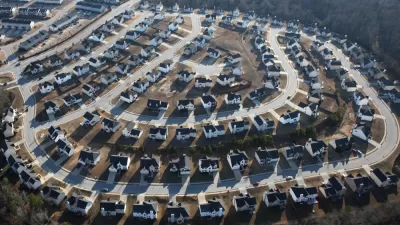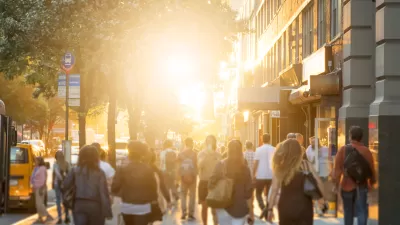Today, I turned in my grades for my seminar on "Sprawl and the Law." It occurred to me that some readers of this blog might be academics, and might be interested on how one can teach a course on sprawl. I began by defining the issue. As I pointed out in an earlier post (at http://www.planetizen.com/node/31063) the term "sprawl" has two common meanings: where we grow (city or suburb) and how we grow (pedestrian-friendly or automobile-dependent). Policies that affect the first type of "sprawl" need not affect the second (and vice versa).
Today, I turned in my grades for my seminar on "Sprawl and the Law." It occurred to me that some readers of this blog might be academics, and might be interested on how one can teach a course on sprawl.
I began by defining the issue. As I pointed out in an earlier post (at http://www.planetizen.com/node/31063) the term "sprawl" has two common meanings: where we grow (city or suburb) and how we grow (pedestrian-friendly or automobile-dependent). Policies that affect the first type of "sprawl" need not affect the second (and vice versa).
Then we discussed the question frequently debated on Planetizen: is sprawl good or bad? I used Oliver Gillham's book, The Limitless City, as a text, since Gillham addresses both sides of the argument. We discussed sprawl's impact on social equity, air pollution, traffic congestion, and a variety of other matters. Because my courses focus on legal issues, I limited our discussion of the pros and cons of sprawl to one class. However, urban planning instructors might wish to devote more time to the question.
But because I teach in a law school, I focused on legal rules relevant to sprawl. I began by focusing on the "how we grow" element of sprawl; since Jacksonville (where I live and teach) is a growing but highly car-dominated city, I believed that this element of sprawl was more relevant to my students than the urban decay common in Rust Belt cities. In particular, I spent most of the course on land use and street design regulations that contribute to sprawl: we read case law on zoning laws segregating land uses, minimum lot size requirements, and minimum parking and setback regulations, as well as examples of, and critiques of, those rules. Similarly, we read and discussed pro-sprawl street design regulations, such as rules mandating wide streets and cul-de-sacs. We then discussed possible solutions to pro-sprawl land use regulation, such as land use deregulation and New Urbanism. And because many of my students had never known anything but sprawl, we made field trips to Jacksonville's most pedestrian-friendly neighborhoods.
The last few weeks of the course were spent on the "where we grow" element of sprawl. We focused on highways and public transit, as well as the pros and cons of land use policies designed to curb suburban development and/or encourage urban redevelopment, such as Oregon's urban growth boundaries and the sort of redevelopment-oriented eminent domain upheld by the Supreme Court in Kelo v. New London. In addition, we spent about an hour or so of class time on the poor quality of urban schools as a driver of suburban migration, and on solutions to this problem (such as vouchers and school finance reform). If I was teaching in a declining city (such as St. Louis) I would have spent more time on "where we grow" sprawl, and in particular on the education issue.

Alabama: Trump Terminates Settlements for Black Communities Harmed By Raw Sewage
Trump deemed the landmark civil rights agreement “illegal DEI and environmental justice policy.”

Planetizen Federal Action Tracker
A weekly monitor of how Trump’s orders and actions are impacting planners and planning in America.

The 120 Year Old Tiny Home Villages That Sheltered San Francisco’s Earthquake Refugees
More than a century ago, San Francisco mobilized to house thousands of residents displaced by the 1906 earthquake. Could their strategy offer a model for the present?

In Both Crashes and Crime, Public Transportation is Far Safer than Driving
Contrary to popular assumptions, public transportation has far lower crash and crime rates than automobile travel. For safer communities, improve and encourage transit travel.

Report: Zoning Reforms Should Complement Nashville’s Ambitious Transit Plan
Without reform, restrictive zoning codes will limit the impact of the city’s planned transit expansion and could exclude some of the residents who depend on transit the most.

Judge Orders Release of Frozen IRA, IIJA Funding
The decision is a victory for environmental groups who charged that freezing funds for critical infrastructure and disaster response programs caused “real and irreparable harm” to communities.
Urban Design for Planners 1: Software Tools
This six-course series explores essential urban design concepts using open source software and equips planners with the tools they need to participate fully in the urban design process.
Planning for Universal Design
Learn the tools for implementing Universal Design in planning regulations.
Clanton & Associates, Inc.
Jessamine County Fiscal Court
Institute for Housing and Urban Development Studies (IHS)
City of Grandview
Harvard GSD Executive Education
Toledo-Lucas County Plan Commissions
Salt Lake City
NYU Wagner Graduate School of Public Service






























